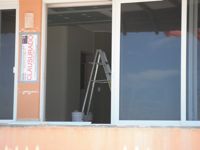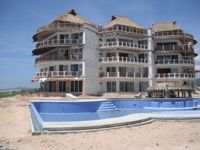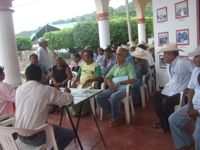Land on the Coast: the forbidden fruit foreigners can't get enough of
Mexico welcomes foreign homebuyers, but it helps if you know the rules before you put your money down.
— Foreigners cannot own land within 50 km of the coastline – it's in the Mexican constitution. However, a foreigner
can possess land if it's held in a bank trust (fideicomiso). With a fideicomiso you have all the rights and obligations of
ownership, including the right to sell your property.
— You can only get a fideicomiso on private land, i.e. property with a clear title (escritura pública). The title is
drawn up by a notary and registered with the district title office (registro) and the state tax office
(recaudación de
rentas).
— Only certain areas of Puerto Escondido and Huatulco are private. All the rest of the coast is held communally. The
different communities (there are over 1,602 in Oaxaca) are the legal owners of the land, which is inalienable (can not be
sold). However, these communities can assign rights to parcels of land to private parties or corporations through an act
of possession (acta or constancia de posesión).
The communal lands of San Pedro Mixtepec and Santa María Colotepec are but two of the 1,602 legally constituted communal and ejido lands in Oaxaca. Every three years a new president and commissioners are elected by the comuneros to administer the property of each bienes comunales. This commission is entirely independent of the municipality. Indeed, many municipalities include two or more bienes comunales. (There are 570 municipalities in Oaxaca.)
The acta allows for the use of the communal property and is transferrable, with each transfer being registered and approved by the communal land office (Bienes Comunales). So, for example, when you “buy” property in Santa María Colotepec you are actually only purchasing the right to use a parcel from someone to whom it had been previously assigned.
The only way communal property can be privatized is through federal expropriation or by an act of the assembly of comuneros.

Vivo Resorts "closed"
After the first building was completed in July, Vivo Resorts was prohibited by the federal environmental agency (SEMARNAT) from continuing construction pending approval of an environmental impact report concerning the change of land use from protected forest to tourist development. The issue is expected to be resolved in the coming months.
Yet land that is not private is sometimes sold as if it were. A case in point is Vivo Resorts — a major condo development being built in Bajos de Chila, a township (agencia) in the municipality (municipio) of San Pedro Mixtepec. Chila was not included in the 1970 expropriation of Puerto Escondido.
Vivo's developers — Cary Mullen and his associate Marco Bruciaga — have attempted, thus far unsuccessfully, to privatize the property, located in the Palmarito area of the Chila coast near the Manialtepec lagoon. Nonetheless, the 48 condos and 44 private home sites included in the first phase of the project are being sold with escrituras. The buyers, almost entirely Canadians, receive fideicomisos, but having a fideicomiso is not a guarantee of the right of ownership. (The bank charges around $500 U.S. per year to hold the title in trust for the foreign owner, but it has no stake in the property.)
Both are legally referred to as social land. An ejido is a federal land grant, often on the site of a former hacienda or plantation. Communal land is territory recognized as historically belonging to a specific, usually indigenous, community.
Bruciaga got constancias (actas) de posesión for the Palmarito land in 2008, but they were not approved by the Bienes Comunales – this led to a lawsuit, now suspended, in January 2009, with the Agrarian Court. In December 2010, Vivo Resorts registered the subdivision of the property into 117 parcels (lotes) as private property with the tax office. As of April 2011, Cary Mullen claimed that 11 condos and 10 home sites had already been sold and that the first building would be ready for occupancy by November.
Meanwhile, back in San Pedro Mixtepec, as of September 2011, the Bienes Comunales still had not approved the Vivo project. Article 91 of their Communal Statute declares all past, present and future titles (escrituras públicas) on its communal land to be invalid. Article 92 states that the beaches and land next to the beaches cannot be transferred to private investors without the consent of the assembly of comuneros. Faced with the fait accompli of Vivo Resorts and recognizing its importance to the local economy, the commission decided to bring the matter of a "change of land use" (cambio de uso de suelo) to a vote by the assembly. The assembly will take place in November, according to Arturo Guadalupe Cortes Loaeza, the president of the commission of the Bienes Comunales.
At a meeting with the Bienes Comunales in August 2011, the commissioners vehemently insisted that there was no plan to bring the issue of privatizing the Vivo land to the assembly. Privatization would require the approval of 75% of the assembly, and the election would have to be witnessed by a notary and by a representative of the Agrarian Judiciary (Procuraduría Agraria). When it was pointed out that it was rather disingenuous to support the construction of the condos on the grounds that it provided employment, while not allowing the Canadian buyers the peace of mind that would come from privatization, the commissioners just shrugged their shoulders.
Comunero
For legal purposes, a comunero is a person whose land has been registered with the National Agrarian Registry (RAN – Registro Agrario Nacional) that was established by a presidential act of 1966. Not everyone chose to register their property - it required a lot of paper work plus the approval of the assembly of the Bienes Comunales. Only registered comuneros can vote in an assembly. The assemblies elect the commissioners. There are approximately 850 registered comuneros in San Pedro Mixtepec, including 85 comuneros who were registered in 2001 and 2002.
There is only one comunero for each property, no matter the size. At the time of registration, the comunero may indicate a successor for when he or she dies.
At present there are only around 150 active comuneros in San Pedro Mixtepec – the rest are dead, infirm or no longer living in the region. The Bienes Comunales is now working with the Procuraduría Agraria to purge the roll of the dead. Then, some time in the future, new comuneros will be allowed to take their place. The new comuneros will have to be voted on by the assembly. Most of the comuneros are over the age of 70.
The process for becoming a comunero is long and arduous. The would-be heir must present a death certificate for the original comunero, who may have died any time since 1966. In the absence of a living, assigned heir, the applicant must have been the comunero’s legal spouse. If there was no marriage or the spouse is dead, the next in line is the common-law spouse. If that person is also dead, then one of the children can apply for the position. However, all the children must give notarized consent. Given the reality of migration, it is very hard for a child of a comunero to apply for acceptance to the registry. At a census of the deceased comuneros held in July 2011 for the purpose of purging of the roll, most of the would-be successors were over the age of 60.
There are no plans at present to allow the thousands of people who have purchased communal land in San Pedro Mixtepec since 1966 to register their land with RAN. The decision to do so is entirely in the hands of the commissioners and the assembly.
Things are done differently in Colotepec where any resident with a federal voting card is allowed to participate in the assembly and to vote for the commissioners. Napoleón Mendoza Mendoza, the president of the Bienes Comunales, explained this deviation from the normal procedure of the RAN by saying it was just the custom (usos y costumbres) of Colotepec.














